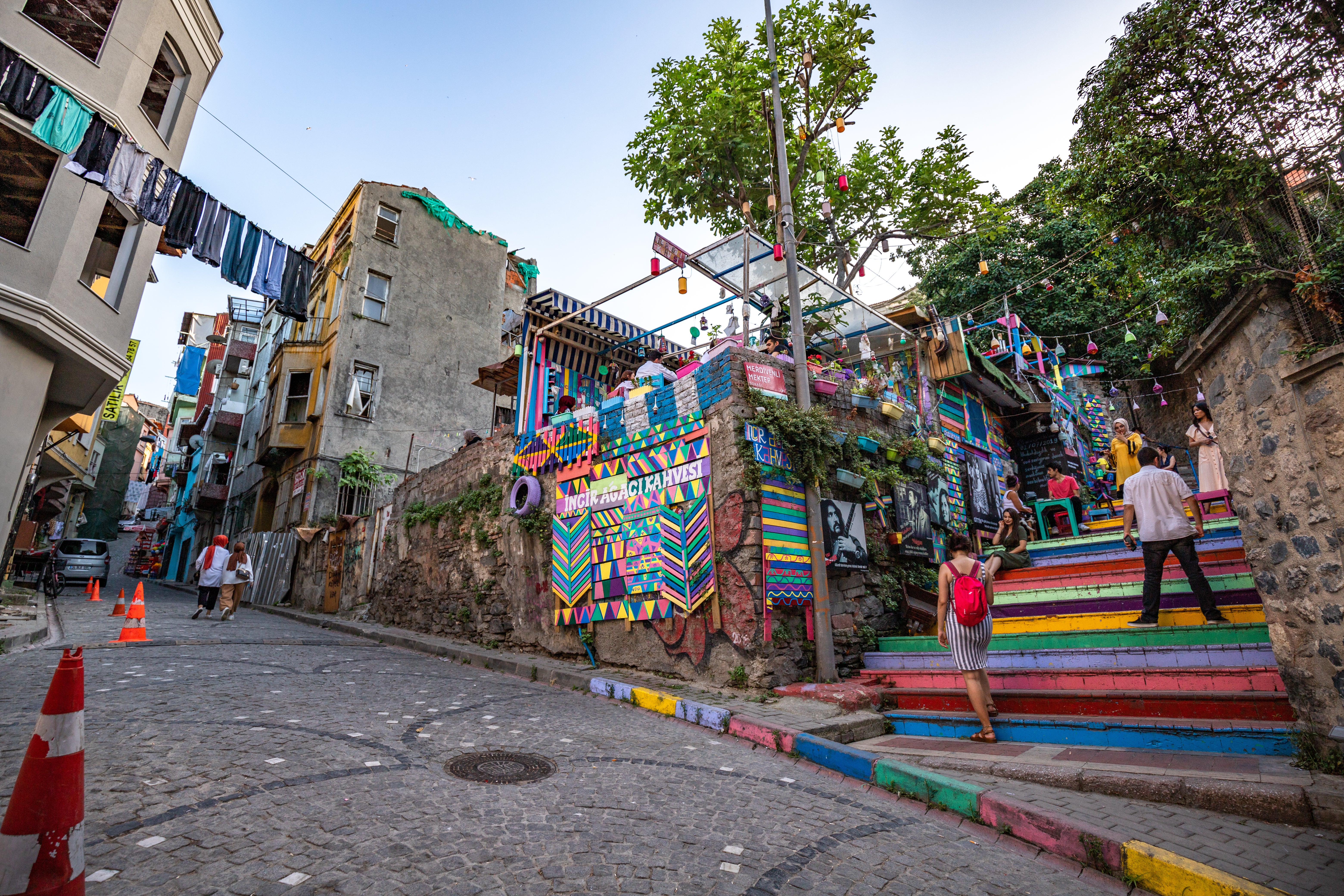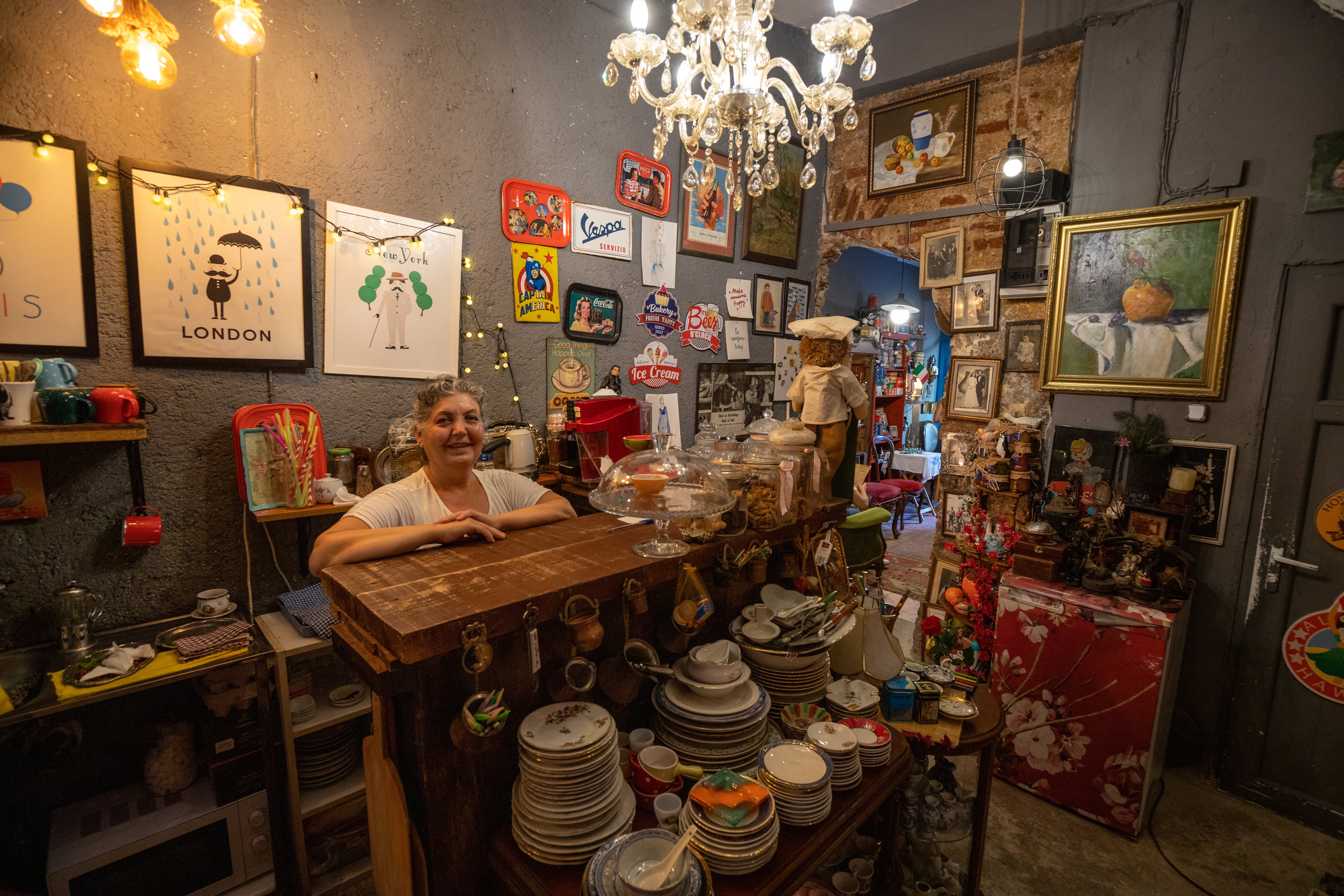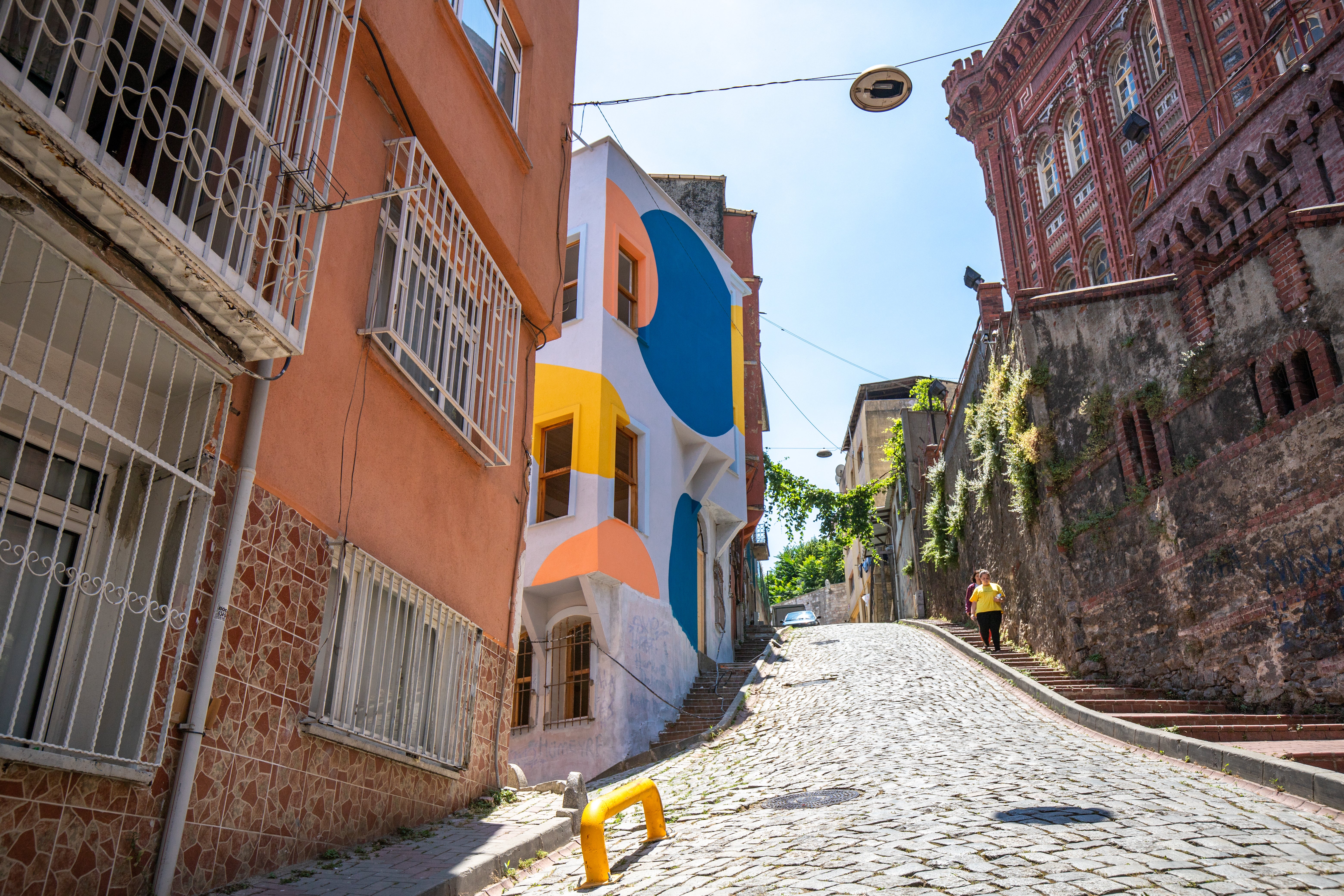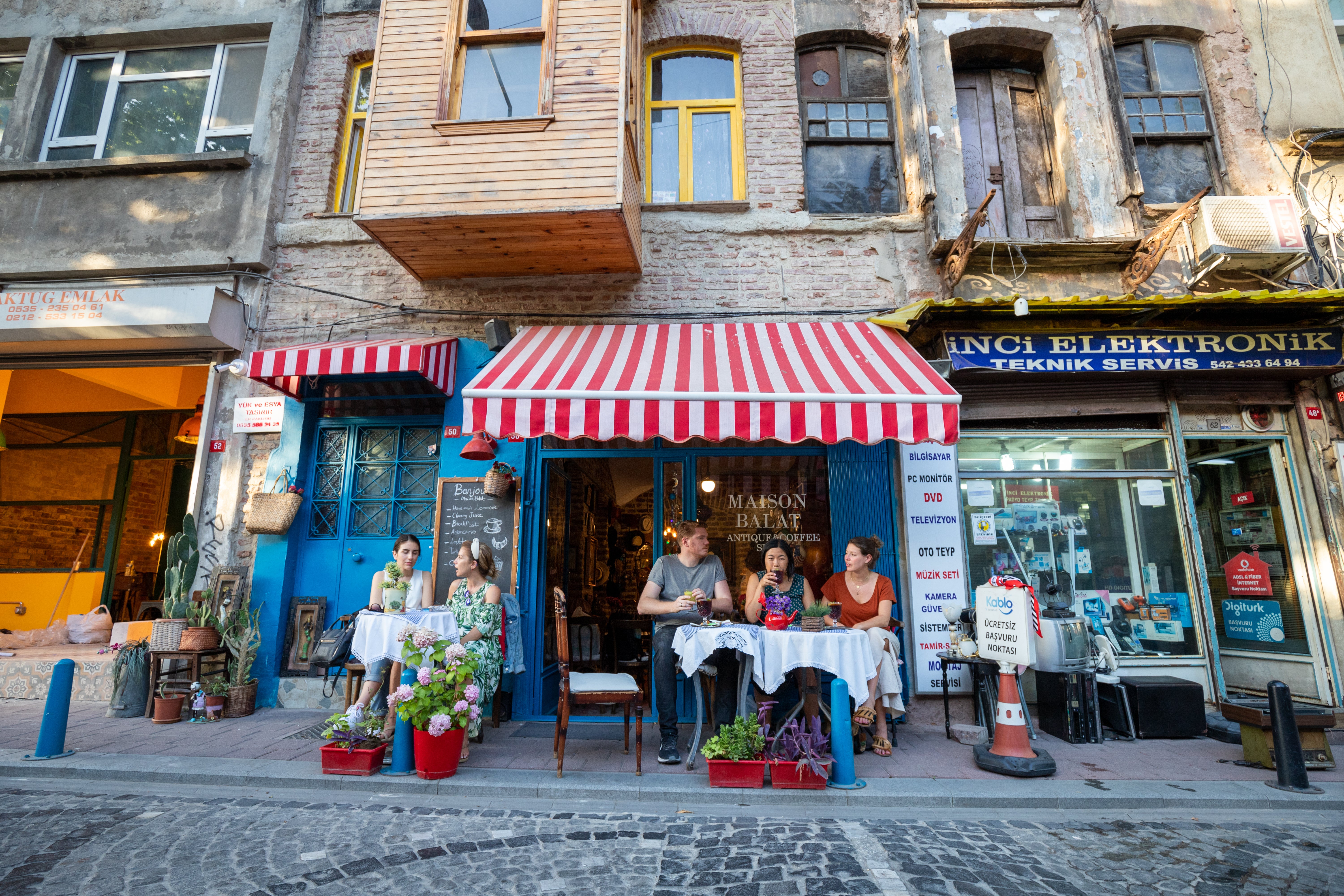Inside Istanbul’s secret rainbow neighbourhood, Balat
Once one of the city’s roughest neighbourhoods, now the cutting-edge star of Instagram and Turkish TV, paintbox-bright Balat is a vivid slice of Istanbul’s culture, says Justin Meneguzzi

The bride is positively glowing on her rainbow staircase. Her broad smile breaks between rouge lips and she bats her plump eyelashes at the photographer, who circles her while a put-upon assistant follows with a silver light reflector.
But where was the groom? It soon becomes clear that there isn’t one – this was just a glamour shoot.
“All the brides are coming here now,” says Jen Hartin. “We get a couple of brides every week who come to take photos because of the colour. It’s just become so popular.”
As an Australian expat living in Balat, a small municipality on the western bank of Istanbul’s Golden Horn, Jen has watched firsthand as the neighbourhood has emerged from its cocoon.
The former tour guide, who has lived here since 2015, expertly guides me down the sometimes steep but always charming streets of Balat, where houses are painted in an array of vibrant colours. From the top window of a purple house, a woman uses a rope to lower a basket to a man on the street, who drops in bread and milk before the lot is greedily pulled back up again.
We pass barbershops brimming with beard trimming and chatter, and beneath a cascade of dangling ivy that shrouds the entrance to Primi Cafe, one of Jen’s favourite haunts. Here, the scent of freshly brewed coffee envelopes young Turks, who eschew traditional black Turkish coffee in favour of sipping lattes. But it wasn’t always this way.

“For a long time, Balat was not considered a good place to live,” Jen explains. “It was a very rough area and was associated with drugs and seedy activity.”
One of Istanbul’s oldest districts, Balat was originally the city’s Jewish Quarter and, from the time of Constantinople to now, housed the city’s minorities – Jewish, Armenian and Greek families who banded together in this predominantly Muslim city.
We pass beneath a bridge of creeping ivy connected to a café, where the scent of freshly brewed coffee envelopes young Turks sipping lattes
But a succession of unfortunate events saw Balat decline. An earthquake in the late 1800s forced many Jewish residents to move, with others leaving after the Second World War to join the formation of Israel. Ongoing conflicts between Turkey and Greece saw population exchanges that further depleted the neighbourhood. Synagogues, churches and houses were neglected until the late 1990s, when Unesco recognised the historical and cultural importance of the rainbow quarter, and invested in restoring it.
Most of Istanbul’s visitors will head to Taksim Square or the Blue Mosque, but clued-in travellers come to Balat to drink coffee and peruse its eccentric shops. The twin streets, Vodina Caddesi and Yıldırım Caddesi, are the lifeblood of the neighbourhood and where we find most of the action. Jen points out shops flaunting vintage handbags and fashion, as well as a glass workshop where visitors can make their own glass necklaces and bracelets. Just off the main thoroughfares, on Mürselpaşa Caddesi, we spy a former generator factory turned modern art gallery, The Pill.
Jen leads me to Maison Balat, a cafe-meets-auction-house offering all manner of bric-a-brac. I find a Japanese robot holding a roll of toilet paper with Vladimir Putin’s face printed on it, nostalgic Coca Cola biscuit tins and oversized nutcrackers. It perfectly captures the bohemian, sometimes irreverent attitude that has attracted so many artists to open around here. Graphic design studio Simge Üngör welcomes me with a cockle-warming sign: the words ‘F*** Off’ embroidered over a red heart. Balat’s carefree spirit is a little jarring – it’s part of the religiously conservative Fatih suburb where, if you turned down a different street, you’d be expected to wear suitably respectful dress.
Çukur, a popular Turkish TV show filmed in Balat, draws young Turkish fans eager to visit the screen home of their favourite mafia characters
Jen and I arrive at BalatKapi, a modern cafe where the owner, Muhittin Danış, greets us in typically Turkish fashion – with an overflowing mezze of menemen eggs, olives, sliced cucumber and tomato, plus fresh honey from his hometown in the east of the country. He tells me the mountain flowers there give it a unique taste, and the honey sings on my tongue as we tuck in. In Turkey, food is what brings people together, and we talk about everything under the sun.
Muhittin tells me left his previous job as chief editor at the Radikal newspaper to open BalatKapi. “Balat is special because it is still looking for its identity,” he says. “I opened my cafe here so I could be part of it. You can’t see this side of Istanbul anywhere else.”
Muhittin’s cafe isn’t the only food star on the block: visitors are also drawn to By Harve Cafe just down the street, Forno Balat for its crispy lahmacun (think paper-thin pizzas), as well as nearby İncir ağacı kahvesi, which looks like a box of pastels exploded inside it. For those willing to go a little further, Balat Sahil Restaurant is a classic seafood meyhane (tavern) where you can pick mezze dishes from a glass cabinet and sip rounds of raki while sepia-coloured portraits of Turkish leaders look on with approval.

Lamentably, Muhittin tells me I’d be lucky to count 30 Jewish, Armenian or Greek families that still live here today. Balat’s Jewish identity has all but eroded away, and some houses have had their unique Armenian facades demolished by new owners. But this is all part of the steady march of history as Balat writes its next chapter.
Unesco’s rejuvenation has brought curious visitors and the colourful streets have exploded in popularity on social media. Çukur, a popular Turkish TV show filmed in Balat, draws young Turkish fans eager to visit the screen home of their favourite mafia characters. All of these things have renewed interest in Balat’s history, the unique architecture of the imposing Phanar Greek Orthodox College, and its orthodox churches. Muhittin says there’s a greater appreciation for Balat’s houses now, and homeowners are now restoring facades rather than tearing them down.
Finding this beautiful architecture isn’t hard when you just need to pick a street and start walking. The brooding Phanar Greek Orthodox College, known as the Red Castle, sits like a fortress on Sancaktar Caddesi, while the ivory and gold-gilded neo-Gothic Bulgarian Church of St. Stephen happily overlooks the river. By contrast, Saint George’s Orthodox Church is far less assuming – as old Ottoman laws stipulated Christian churches must be built smaller than mosques – but worth a visit for its lavish interior and fulsome chandeliers.
But for all its newfound fame, Jen says Balat still feels small – which, in a sprawling metropolis like Istanbul, means something.
“I know my butcher. I know my baker. There are no big supermarket chains in Balat. It feels like the small country town in Australia where I grew up, and where you get to know everybody. I feel like I’m home here.”

Getting there
Trying to fly less?
You can travel to Istanbul from the UK entirely by train – going London to Paris via Eurostar, Paris to Munich on a TGV service, then on to Budapest (multiple services including the Kalman Imre sleeper train), then Bucharest on the Ister sleeper train. From Bucharest’s Gara de Nord, there’s a Bosfor train to Istanbul Halkali from June to October – out of that season you can catch local trains through Bulgaria to Dimitrovgrad, changing in Ruse & Gorna Orjahovitsa, then catch a direct train to Istanbul. The whole thing should take three or four days, with plenty of potential for fascinating stopovers.
Fine with flying?
Direct flights from London to Istanbul are available with many airlines, including British Airways and Turkish Airlines. Within Istanbul, Balat is easily accessible by bus, taxi or ferry.
Staying there
The Haze Karaköy is an affordable four-star hotel in Istanbul’s buzzing harbourside district, where you’ll find alleyways full of restaurants and cafes, dessert shops filled with baklava and Galata Tower a stone’s throw away.
Top tour
Local walking tour company My Local Guides offers the Istanbul Heritage day tour, which includes a cruise along the Golden Horn, cable car ride, a taste of Turkish tea and a stroll through Balat. Tickets are €50pp for adults and €35pp for children aged 6 to 11.
Visit the UK government’s foreign travel advice for most up to date information on travel to Turkey.






Join our commenting forum
Join thought-provoking conversations, follow other Independent readers and see their replies
Comments